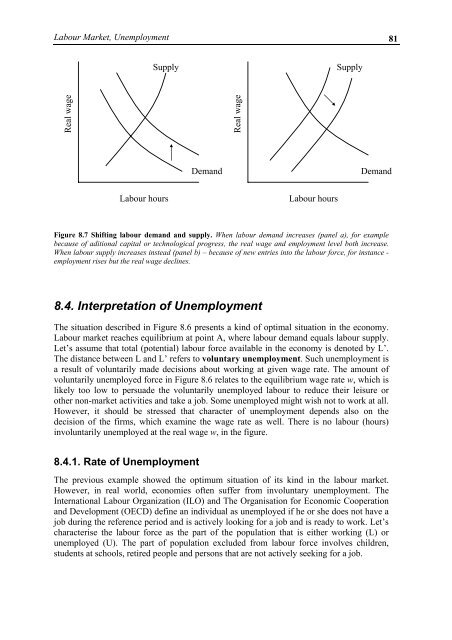MacroeconomicsI_working_version (1)
Create successful ePaper yourself
Turn your PDF publications into a flip-book with our unique Google optimized e-Paper software.
Labour Market, Unemployment 81<br />
Supply<br />
Supply<br />
Real wage<br />
Real wage<br />
Demand<br />
Demand<br />
Labour hours<br />
Labour hours<br />
Figure 8.7 Shifting labour demand and supply. When labour demand increases (panel a), for example<br />
because of aditional capital or technological progress, the real wage and employment level both increase.<br />
When labour supply increases instead (panel b) – because of new entries into the labour force, for instance -<br />
employment rises but the real wage declines.<br />
8.4. Interpretation of Unemployment<br />
The situation described in Figure 8.6 presents a kind of optimal situation in the economy.<br />
Labour market reaches equilibrium at point A, where labour demand equals labour supply.<br />
Let’s assume that total (potential) labour force available in the economy is denoted by L’.<br />
The distance between L and L’ refers to voluntary unemployment. Such unemployment is<br />
a result of voluntarily made decisions about <strong>working</strong> at given wage rate. The amount of<br />
voluntarily unemployed force in Figure 8.6 relates to the equilibrium wage rate w, which is<br />
likely too low to persuade the voluntarily unemployed labour to reduce their leisure or<br />
other non-market activities and take a job. Some unemployed might wish not to work at all.<br />
However, it should be stressed that character of unemployment depends also on the<br />
decision of the firms, which examine the wage rate as well. There is no labour (hours)<br />
involuntarily unemployed at the real wage w, in the figure.<br />
8.4.1. Rate of Unemployment<br />
The previous example showed the optimum situation of its kind in the labour market.<br />
However, in real world, economies often suffer from involuntary unemployment. The<br />
International Labour Organization (ILO) and The Organisation for Economic Cooperation<br />
and Development (OECD) define an individual as unemployed if he or she does not have a<br />
job during the reference period and is actively looking for a job and is ready to work. Let’s<br />
characterise the labour force as the part of the population that is either <strong>working</strong> (L) or<br />
unemployed (U). The part of population excluded from labour force involves children,<br />
students at schools, retired people and persons that are not actively seeking for a job.




